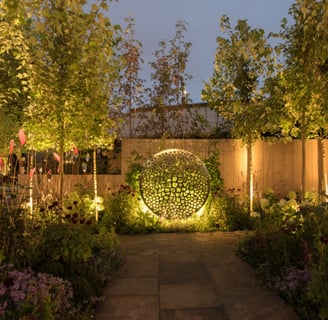A Light in the Garden—Or a Light Too Far?
A gentle look at garden lighting in shaded spaces—how to create atmosphere without disturbing wildlife. Discover tips for choosing eco-friendly lighting that complements your garden's natural rhythm.
GARDEN DESIGN & ATMOSPHERE
Marcus Bergin
5/23/20252 min read


You know that magical moment when dusk settles and the garden glows in a soft, golden hue? It’s tempting, isn’t it, to add a bit of sparkle—solar lights along the path, a spotlight on your favourite fern, maybe even a warm glow under a tree to make the shadows dance.
And in shade gardens, where dappled light is part of the charm, the idea of a bit of gentle evening light feels like a perfect finishing touch.
But here’s something I’ve been thinking about more and more:
Are we lighting up the garden—or crowding out the night?
Garden lighting can be beautiful, no doubt. It lets us enjoy our outdoor spaces later into the evening, especially in the height of summer. But it also brings with it a quiet cost—one we don’t always see straight away.
You see, artificial lighting can confuse and disrupt the natural patterns of wildlife. Moths and pollinators rely on the dark for navigation. Too much light, and they can become disoriented, circling lamps instead of finding the flowers they’re meant to pollinate. Some birds, too, are tricked into singing through the night or beginning their day far too early. Even frogs and hedgehogs get thrown off their rhythms by bright, unnatural light.
And if you’ve ever wondered why some parts of your garden don’t seem as alive at dusk as they used to, it might just be because of too much glow.
So what’s the answer?
You don’t need to give up lighting entirely, but you can choose it thoughtfully.
Here are a few gentle ways to light up your garden without drowning out the dark:
Use low, warm lighting: Avoid blue-white tones. Warmer colours (2700K or less) are less disruptive to wildlife and easier on the eyes.
Shield your lights: Use downward-facing fixtures that light only the path or area needed. No need to beam it into the treetops!
Timers or motion sensors: Let the lights come on only when needed, not all night.
Solar with care: Some solar lights stay on all night—choose ones with cut-off timers or that only glow for a short while.
Go natural instead: Reflect moonlight with pale gravel paths, silver-leaved plants like Brunnera, or white blooms that shine in the twilight—nature’s own version of garden lighting.
Shade gardens already teach us the joy of subtlety—the way a glint of light through the leaves can be more beautiful than full sun. Maybe it’s time our garden lighting followed that same lesson.
What’s your take on garden lighting? Have you found a balance that works for both your space and your wildlife visitors? I’d love to hear what you’re using—and what you’ve chosen to leave out.
That’s all it takes today—go on, give it a go.
Happy Gardening.